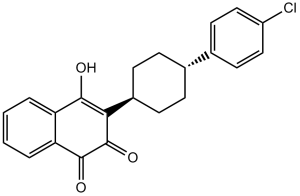This product is for research use only, not for human use. We do not sell to patients.

| Size | Price | Stock |
|---|---|---|
| 1g | $345 | Check With Us |
| 5g | $1050 | Check With Us |
| 10g | $1575 | Check With Us |
Cat #: V2396 CAS #: 95233-18-4 Purity ≥ 98%
Description: Atovaquone (also called atavaquone) is a hydroxynaphthoquinone based antiprotozoal and antimicrobial medication used to treat or prevent for pneumocystis pneumonia, toxoplasmosis, malaria, and babesia. Atovaquone is a chemical compound that belongs to the class of naphthalenes. Atovaquone is a hydroxy-1,4-naphthoquinone, an analog of ubiquinone, with antipneumocystic activity. Atovaquone is an anti-protozoal mitochondrial electron transport inhibitor; Antimalarial; Antipneumocystic, and has also been used to treat toxoplasmosis. It acts by inhibiting the cytochrome bc(1) complex via interactions with the Rieske iron-sulfur protein and cytochrome b in the ubiquinol oxidation pocket.
Publications Citing InvivoChem Products
Product Promise

- Physicochemical and Storage Information
- Protocol
- Related Biological Data
- Stock Solution Preparation
- Quality Control Documentation
| Molecular Weight (MW) | 366.84 |
|---|---|
| Molecular Formula | C22H19ClO3 |
| CAS No. | 95233-18-4 |
| Storage | -20℃ for 3 years in powder formr |
| -80℃ for 2 years in solvent | |
| Solubility In Vitro | DMSO: 5 mg/mL (13.6 mM)r |
| Water: <1 mg/mLr | |
| Ethanol: <1 mg/mL | |
| Solubility In Vivo | 5% DMSO+Corn oil: 0.5mg/mL |
| SMILES Code | O=C1C([C@H]2CC[C@H](C3=CC=C(Cl)C=C3)CC2)=C(O)C(C4=C1C=CC=C4)=O |
| Synonyms | Atavaquone; 566C; 566C80; 566C80 hydroxynaphthoquinone; Mepron; Wellvone |
| Protocol | In Vitro | In vitro activity: Atovaquone (atavaquone) is a chemical compound that belongs to the class of naphthalenes. Atovaquone is a hydroxy-1,4-naphthoquinone, an analog of ubiquinone, with antipneumocystic activity. Atovaquone is an anti-protozoal mitochondrial electron transport inhibitor; Antimalarial; Antipneumocystic, and has also been used to treat toxoplasmosis. It acts by inhibiting the cytochrome bc(1) complex via interactions with the Rieske iron-sulfur protein and cytochrome b in the ubiquinol oxidation pocket. Kinase Assay: Atovaquone is a medication used to treat or prevent for pneumocystis pneumonia, toxoplasmosis, malaria, and babesia. Target: Antiparasitic Atovaquone (atavaquone) is a chemical compound that belongs to the class of naphthalenes. Atovaquone is a hydroxy-1,4-naphthoquinone, an analog of ubiquinone, with antipneumocystic activity. Atovaquone is an anti-protozoal mitochondrial electron transport inhibitor; Antimalarial; Antipneumocystic, and has also been used to treat toxoplasmosis. It acts by inhibiting the cytochrome bc(1) complex via interactions with the Rieske iron-sulfur protein and cytochrome b in the ubiquinol oxidation pocket. Atovaquone is a unique naphthoquinone with broad-spectrum antiprotozoal activity. It is effective for the treatment and prevention of Pneumocystis carinii pneumonia (PCP), it is effective in combination with proguanil for the treatment and prevention of malaria, and it is effective in combination with azithromycin for the treatment of babesiosis. |
|---|---|---|
| In Vivo | Atovaquone is a unique naphthoquinone with broad-spectrum antiprotozoal activity. It is effective for the treatment and prevention of Pneumocystis carinii pneumonia (PCP), it is effective in combination with proguanil for the treatment and prevention of malaria, and it is effective in combination with azithromycin for the treatment of babesiosis. | |
| Animal model | ICSBP−/− mice infected with 10 cysts of the ME49 strain of T. gondii | |
| Dosages | 100 mg/kg | |
| Administration | Oral administration |
| Solvent volume to be added | Mass (the weight of a compound) | |||
|---|---|---|---|---|
| Mother liquor concentration | 1mg | 5mg | 10mg | 20mg |
| 1mM | 2.7260 mL | 13.6299 mL | 27.2598 mL | 54.5197 mL |
| 5mM | 0.5452 mL | 2.7260 mL | 5.4520 mL | 10.9039 mL |
| 10mM | 0.2726 mL | 1.3630 mL | 2.7260 mL | 5.4520 mL |
| 20mM | 0.1363 mL | 0.6815 mL | 1.3630 mL | 2.7260 mL |
This equation is commonly abbreviated as: C1 V1 = C2 V2
- (1) Please be sure that the solution is clear before the addition of next solvent. Dissolution methods like vortex, ultrasound or warming and heat may be used to aid dissolving.
- (2) Be sure to add the solvent(s) in order.




































